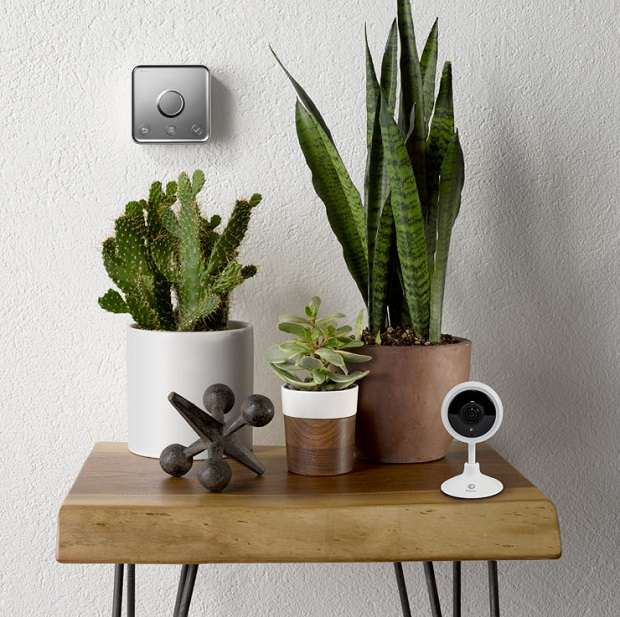If your home is your castle, then the modern day equivalent of moats, ramparts and battlements are the smartphone apps, key fob chains or other smart home devices such as Amazon Alexa that control its access and protection.
Yes, when it comes to home security, things have moved with the times so much that while traditional keys and locks still obviously have their place in the fight against crime, it's connected technology that can add an extra, more effective layer of protection. It will track and record movement when you're not in the house and will instantly alert you if there's something amiss.
Here are a few things to consider when boosting your home's protection, both the tried and tested and some of the latest developments.
The basics
Start your property search
It's worth reiterating the common sense stuff because it's very easy to get complacent about protecting our homes. Try not to cost-cut when it comes to window and door locks and screen doors - quality materials and fixtures will work to slow thieves down, and every second counts. Avoid leaving ladders and expensive items lying around on your property that attract attention, and if you're away for a while, tell the neighbours and get someone to clear your mail. Also, don't leave laptops, iPads and other such desirable items in places where they're visible through windows.
Do be alarmed
An alarm remains an excellent deterrent and these days doesn't have to be activated or turned off solely via a keypad at your entry point. Rather, you can operate them remotely from smartphone apps, which can even set the alarm when its sensors detect the house is empty and can send out alerts if it is disturbed; or via a clever key fob which works like a modern car key, meaning you're not required to memorise a code.
The latest outdoor cameras usually have motion detectors that will email you or talk to your phone if activated, have night vision and double as sensor lights, and most have cloud storage too. Other options for detecting entry include window sensors.
Scott Carter, CEO of Matrix Security, says it's rare to find houses without alarm systems today, much like finding a car without electric windows, and that the advent of smart technology combined with the broadband rollout has made it a lot easier for homeowners to use their smartphones to set and unset alarms, as well as monitor them. These days, alarm systems are more than bells and whistles, he says.
"Alarms are now more like building management systems that can control anything that requires an input, but most people just want a security system that will detect an intruder."
While the trend for self-monitoring is growing, most people still want a professional to act for them if any issues arise, and residential patrols such as those pioneered by Matrix in central Auckland suburbs are still popular, he says.
Get smarter
Technology is getting smarter and more comprehensive when it comes to home security. Global company Swann Security has a range of interconnected products, available at outlets such as Noel Leeming, Bunnings and Harvey Norman, that form part of a "complete security ecosystem" controlled via a single smartphone app. The Swann Security app can monitor different types of cameras from multiple locations, stream live video and send notifications, as well as being integrated with Google Assistant and Amazon Alexa.

Wire free tracker cameras sends notifications or can be monitored from any location. Photo / supplied
Swann Security's new releases for 2020 focus on preventative security and catching crime before it happens, and include a wire-free security camera and wire-free video doorbell and chime unit. The cameras have a 180-degree viewing angle, full HD 1080p video resolution, 10-person facial recognition and two-way talk features, while footage can be stored for free in the company's secure cloud server or locally.
Swann's award-winning compact Wi-Fi security tracker camera can track and record moving objects with auto-zoom on to a MicroSD card. The company says the quality of the video is clear enough to clearly identify faces and clothing patterns at any time of the day or night, and the company has a super-wide 180-degree viewing angle that is flattened to avoid the rounded fish-eye effect.
Lock sharp
Another trend continuing to rise is the smart lock allowing keyless entry to your home via touch. Kwikset's Kevo locks are controlled by Bluetooth, your smartphone and other smart devices; the app keeps track of who is coming and going, and it gives you the option to send 24-hour e-keys to anyone you'd like to let inside while you're not there. You can lock and unlock the door via the app from within the house too, or remotely if you've left without activating the lock, and the app can also send notifications if desired. Kwikset's new Halo Touch smart lock, which will be released later this year, has fingerprint-recognition technology and is able to store up to 100 fingerprints for 50 users at any time, with the prints stored locally as opposed to the cloud. This smart lock will work via Wi-Fi.
Light up your life
Along with attention-seeking alarms, a robust lighting system can assist in home protection. The latest technology allows you to control lighting from your smartphone to make it seem like someone is home at night, activate lighting for a safe path to your front door and beyond, and even illuminate your outdoor spaces if you hear a noise in the night. The Philips Hue smart lighting system can be set up to mimic your evening habits when you're not home, even varying slightly to make patterns seem more natural.
















































































